Resumen ejecutivo
Bank filtration is the infiltration of surface water, mostly from a river system into a groundwater system induced by water abstraction close to the surface water (e.g. a river bank). This water abstraction is commonly done by operating wells. As the water flows through the soil, it is filtered and its quality hence is improved. In the context of developing or newly-industrialised countries, bank filtration may contribute to a more sustainable water cycle by recharging stressed groundwater bodies with filtered surface water (SHARMA & AMY 2009; HUELSHOFF et al. 2009).
| Entradas | Salidas |
|---|---|
Freshwater, Drinking Water |
Introduction
Bank Filtration (BF) has been common practice in many European cities for more than 100 years. It was originally initiated to remove pathogens and suspended solids from increasingly polluted surface waters. Increasing demand required adaptations such as sand layers incorporated in percolation ditches (SCHMIDT et al. 2003).
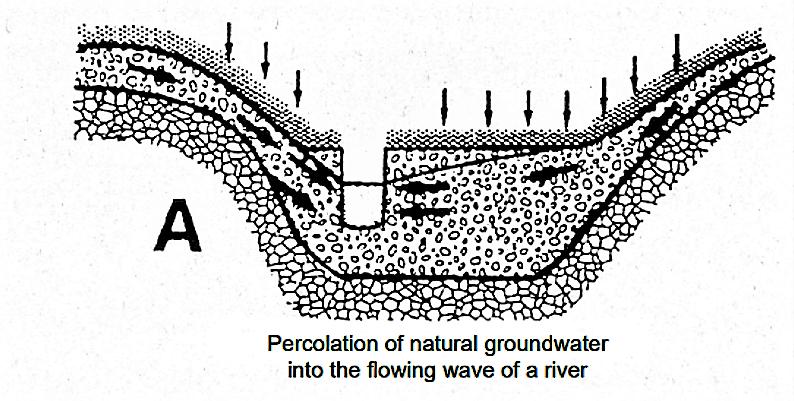
For drinking water production, BF is regarded as a possible pre-treatment step within the multi barrier approach in the overall treatment chain recommended by the WHO (2011). BF can potentially reduce or stabilise the microbial, natural organic matter and particulate load. It makes drinking water safer and more acceptable for the consumer, but not all undesired substances can be removed during soil and aquifer passage (SCHMIDT et al. 2003; HUELSHOFF et al. 2009, Relevance and Opportunities). The BF method prevents from shock loads and assures the removal of particles, biological contaminants and biodegradable compounds (SCHMIDT et al. 2003). Furthermore it allows for temperature adjustment.
Besides the treatment of surface water for drinking purposes, BF is also a managed aquifer recharge (MAR) technique, since the water flows through the soil and mixes with the existing groundwater from the aquifer. MAR is used to enhance the quality of treated sewage and surface water for both drinking and non-drinking purposes and prevents overuse of aquifers, saltwater intrusion and land subsidence (also see soil aquifer treatment, surface groundwater recharge and subsurface groundwater recharge).
How Does Bank Filtration Work?
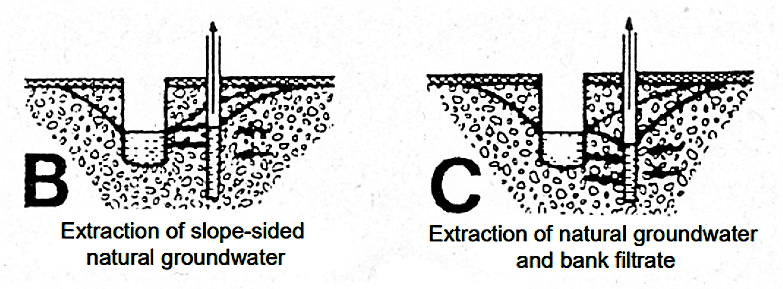
BF is the abstraction of water from aquifers that are hydraulically connected to a surface water body, which in most cases is a river or a riverine system. By pumping from wells adjacent to a surface water body, the groundwater table is lowered and water from the surface water body infiltrates into the aquifer. This so-called bank filtrate percolates through the soil towards the production wells (e.g. a borehole) where it mixes with the ambient (or natural) groundwater (HISCOCK & GRISCHEK 2002).
The beneficial filtration process occurs mainly in two zones: a biologically active layer where intensive degradation and adsorption processes occur within a short residence time; and along the main flow path between the surface water body and the abstraction well where degradation rates and sorption capacities are lower and mixing processes more quickly (HISCOCK & GRISCHEK 2002; SCHMIDT et al. 2004).
Beneficial Effects of Bank Filtration
Due to its easy implementation and little maintenance requirements, BF is considered to be a useful drinking water (pre-)treatment method for developing and newly-industrialised countries. BF systems are particularly known for the efficient removal of pathogens, suspended solids, toxic algae, or organic trace compounds (e.g. pharmaceutical products) from surface water, all being water quality parameters of high relevance (SPRENGER et al. 2006; HUELSHOFF et al. 2009). Experience from Europe has demonstrated that BF is suitable to remove a range of organic and inorganic contaminants while an exhaustion of cleaning capacity has not been observed (SCHMIDT et al. 2003).
BF offers freshwater storage in times of heavy precipitation (e.g. during monsoon) or elevated stream run-off (e.g. snow melt from higher altitudes). Underground freshwater stocks are protected from evaporation and deterioration (JIMENES 2008). They can be stored until dry weather conditions require groundwater abstraction to meet water demand (HUELSHOFF et al. 2009). This will be increasingly useful with the more extreme weather patterns that are being anticipated with climate change and that pose challenges to developing countries, which are usually more vulnerable to water shortages or flooding (HUELSHOFF et al. 2009).
BF systems can mitigate shock loads resulting from chemical spills or defects in industrial wastewater plants. Furthermore, they can even out temperature differences between surface water and groundwater aquifers; for instance when rivers receive cooling water from a power station (SCHMIDT et al. 2003).
Because of its relatively low cost and the fact that neither high-tech nor highly skilled labour is required, BF is suitable as a water purification tool in developing countries (SPRENGER et al. 2006).
Treatment Processes of Bank Filtration
(Adapted from HUELSHOFF et al. 2009)
Several physical, chemical and biochemical processes are responsible for the improvement of water quality during subsurface passage (SHARMA & AMY 2009). The processes that remove substances in the bank filtrate include:
- Straining or filtration: The mechanical filtration process retains suspended matter in the soil, depending on pore throat size.
- Biodegradation and decay: biodegradation and radioactive decay are the only sustainable removal processes. Biodegradation is the main driver for redox processes occurring during subsurface passage and is responsible for the breakdown of dissolved and/or sediment-bound organic matter.
- Sorption and desorption: Trace elements such as iron, manganese and various heavy metals are eliminated during ground passage, mainly by sorption processes (SCHMIDT et al. 2003) and by accumulating on the surface of an adsorbent or substrata. Biological contaminants such as protozoa, bacteria and viruses are reduced by a combination of processes including adsorption to aquifer materials and inactivation (SCHMIDT et al. 2003).
- Ion exchange: In aerobic aquifers, removal is achieved by ion exchange processes at negatively loaded surfaces of clay minerals, amorphous ferric oxides and alumina and organic solid matter (SCHMIDT et al. 2003).
- Chemical precipitation: In anoxic aquifers, the removal of metal ions is dominated by precipitation reactions with sulphide (SCHMIDT et al. 2003) when insoluble compounds form and precipitate from the solution.
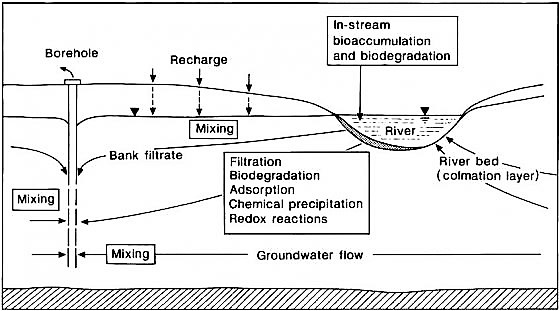
The removal of biological contaminants through BF is most efficient when groundwater velocity is slow and when the aquifer consists of granular materials with high grain surface contact. Levels of many organic micropollutants can be reduced or even eliminated during both aerobic and anaerobic underground passages (MUELLER et al. 2010; MAENG et al. 2009). Attenuation is extremely dependant on the underlying redox processes (SCHMIDT et al. 2004). The purification capacity of BF schemes regarding surface-water pollutants depend on (SCHMIDT et al. 2003):
- Quality of the surface water
- Geological conditions
- Porosity of the soil (flow velocity)
- Covered distance determined by the permeability
- Hydraulic residence time of the water in the soil
- Hydraulic potential in the aquifer
- Temperature (see HUELSHOFF et al. 2009)
- PH-values
- Oxygen concentration
Despite BF being widespread in Central Europe, knowledge about processes during BF is still scarce. Especially information about the physical, chemical and biological processes of water purification, extension of the active sand filter zone, significance of bank vegetation for water purification, hydraulic permeability with its clogging phenomenon (GUENTER 2011) and influence of changing environmental conditions on the operation of BF schemes is rare (HUELSHOFF et al. 2009).
Examples of Bank Filtration
BF provides about 50% of potable water supplies in the Slovak Republic and 45% in Hungary (HISCOCK & GRISCHEK 2002). In Germany, more than 300 water works use BF and about 16% of German drinking water is produced from bank filtrate.
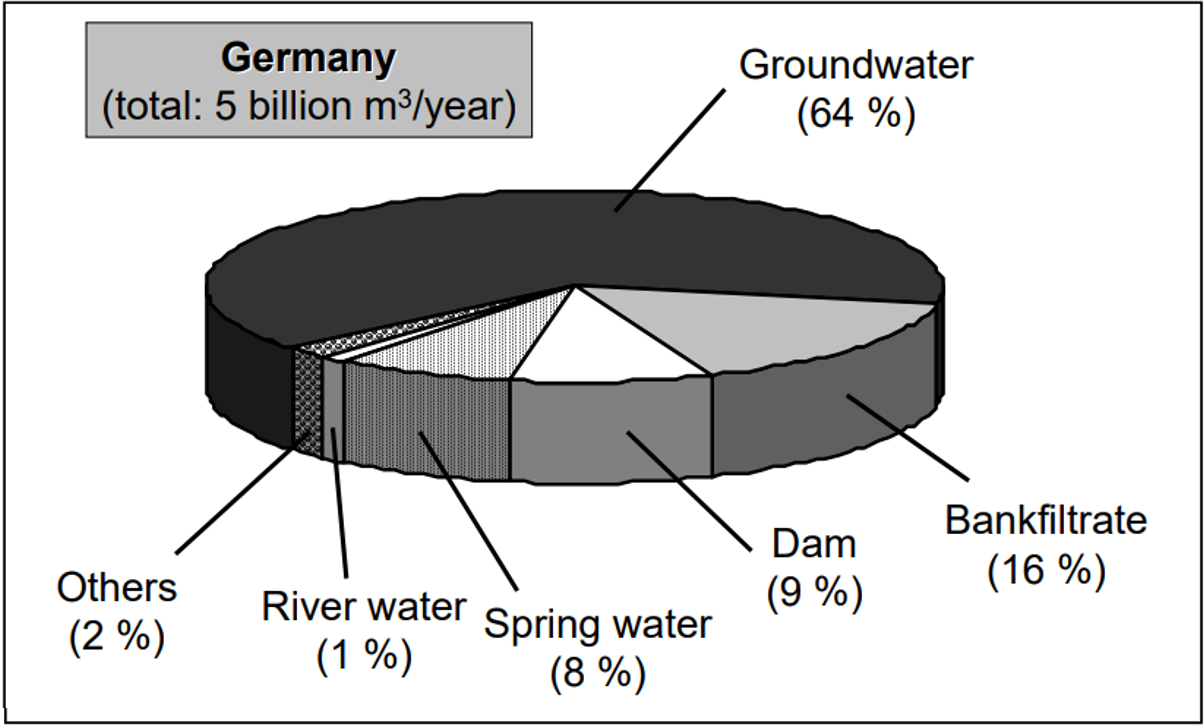
In Central Europe, increasing chemical pollution, high concentrations of ammonia, organic compounds and micropollutants in the river water called for the introduction of supplementary pre- and post-treatment steps to build up a multi-barrier system. Aeration or ozone may be used to oxidise iron and manganese, or to activate carbon for adsorption of and protection against more persistent contaminants.
Today nearly all water utilities situated along large rivers use granular activated carbon filters, often combined with isolation and filtration (SCHMIDT et al. 2003).
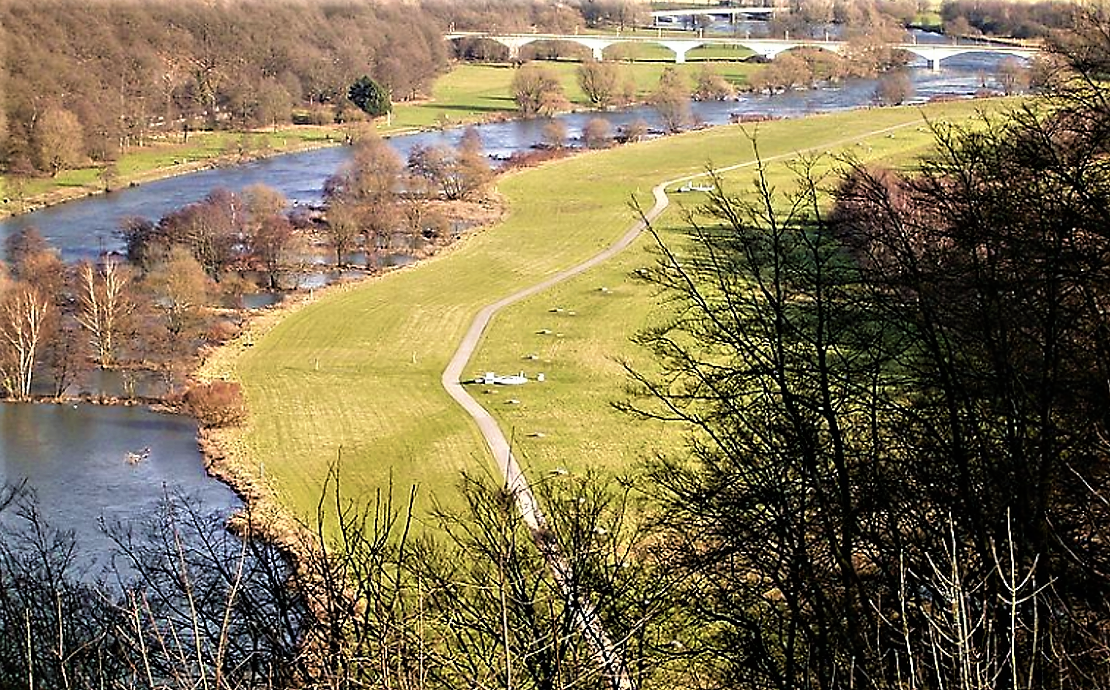
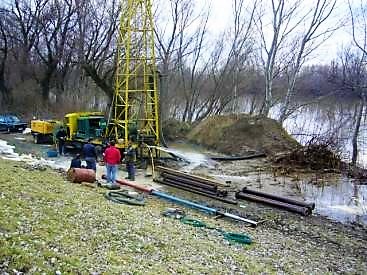
(Adapted from HUELSHOFF et al. 2009)
For the operation of a BF system, some basic requirements have to be met. The availability of surface water as a primary source is essential. A second major consideration is the groundwater level in the surroundings of the BF well. They should not decline below an ecologically and economically justifiable threshold value due to operation. Water abstraction should not result in adverse effects on the aquifer (overexploitation, damage to ecosystems) or the river downstream of the BF site (e.g. dependent settlements being water-deprived).
The design of BF systems usually requires a detailed hydro-geological site investigation and knowledge about the hydrological characteristics of the catchment. A successful BF operation depends on surface water quality, soil texture and soil quality.
The quality of water (e.g. salinity) and the soil at the geologic site (e.g. amount and solubility of arsenic content, redox conditions) are factors to be assessed prior to water abstraction for potable use. Pollutants in soil may be of geogenic (e.g. arsenic) or anthropogenic origin (e.g. heavy metals from an industrial site, nitrate from agriculture) and render bank filtrate objectionable.
Further, the soil texture should have filter properties. Limestone and dolomite bedrocks, for instance, are rich in fissures and allow for rapid water travel times. They are therefore unfavourable for the removal of water contaminants. Suitable soil textures for BF are sand and gravel aquifers with hydraulic conductivities kf (permeability) greater than 0.0001 m/s, a minimal thickness of 5 m and a good hydraulic connexion to the adjacent surface water (TZW 2006).
Bank Filtration for Drinking Water Treatment. The Significance of the Water-Sediment Transition Zone
Attenuation of Groundwater Pollution by Bank Filtration
Analysis of the Vulnerability of Bank Filtration Systems to Climate Change by Comparing Their Effectiveness Under Varying Environmental Conditions
This technical paper explains the vulnerability of bank filtration systems to climate change like the effect of changing temperature or raw water quality and quantity. It also features a case study from Berlin, Germany, where 60% of the water abstracted from wells is due to bank filtration schemes.
HUELSHOFF, I. GRESKOWIAK, J. GRUETSMACHER, G. (2009): Analysis of the Vulnerability of Bank Filtration Systems to Climate Change by Comparing Their Effectiveness Under Varying Environmental Conditions. Unknown: Techneau URL [Visita: 04.03.2019] PDFRelevance and Opportunities of Bank Filtration to Provide Safe Water for Developing and Newly-industrialised Countries
This report gives an overview of the opportunities that BF provides for developing and newly-industrialised countries. The information should support these countries in evaluating whether BF constitutes an attractive supplement or even alternative to their water supply system.
HUELSHOFF, I. GRESKOWIAK, J. WIESE, B. GRUETSMACHER, G. (2009): Relevance and Opportunities of Bank Filtration to Provide Safe Water for Developing and Newly-industrialised Countries. Unknown: Techneau URL [Visita: 04.03.2019] PDFHealth Risk in Aquifer Recharge with Recycled Water
Guidelines and Prediction Tool for Pharmaceuticals Removal During Bank Filtration
A New Approach to Calculate EMEA’s Predicted Environmental Concentration for human Pharmaceuticals in Groundwater at Bank Filtration Sites
Assessing the Impact of Different Redox Conditions and Residence Times on the Fate of Organic Micropollutants during Riverbank Filtration
Bank Filtration – A Sustainable Water Treatment Technology for Developing Countries
Based on the results of two feasibility studies conducted in Malawi and Kenya, this paper explains the potentials and constraints of promoting the bank filtration technology for water treatment in developing countries.
SHARMA, S.K. AMY, G. (2009): Bank Filtration – A Sustainable Water Treatment Technology for Developing Countries. (= 24th WEDC International Conference, Addis Ababa, Ethiopia ). Delft: UNESCO-IHE URL [Visita: 24.08.2011]Occurence and Fate of Microbial Pathogens and Organic Compounds at Riverbank Filtration Sites in Delhi, India
Exportorientierte F&E auf dem Gebiet der Wasserver- und entsorgung.
Construction of Bank Filtration Wells in the Vojvodina Region
Bank Filtration Recovery Wells at the Ruhr River in Hattingen, Germany
Guidelines for Drinking-water Quality, Fourth Edition
This volume of the Guidelines for Drinking-water Quality explains requirements to ensure drinking-water safety, including minimum procedures and specific guideline values, and how those requirements are intended to be used. The volume also describes the approaches used in deriving the guidelines, including guideline values. It includes fact sheets on significant microbial and chemical hazards.
WHO (EDITOR) (2011): Guidelines for Drinking-water Quality, Fourth Edition. Geneva: World Health Organization (WHO) URL [Visita: 11.07.2018]Relevance and Opportunities of Bank Filtration to Provide Safe Water for Developing and Newly-industrialised Countries
This report gives an overview of the opportunities that BF provides for developing and newly-industrialised countries. The information should support these countries in evaluating whether BF constitutes an attractive supplement or even alternative to their water supply system.
HUELSHOFF, I. GRESKOWIAK, J. WIESE, B. GRUETSMACHER, G. (2009): Relevance and Opportunities of Bank Filtration to Provide Safe Water for Developing and Newly-industrialised Countries. Unknown: Techneau URL [Visita: 04.03.2019] PDFBank Filtration – A Sustainable Water Treatment Technology for Developing Countries
Based on the results of two feasibility studies conducted in Malawi and Kenya, this paper explains the potentials and constraints of promoting the bank filtration technology for water treatment in developing countries.
SHARMA, S.K. AMY, G. (2009): Bank Filtration – A Sustainable Water Treatment Technology for Developing Countries. (= 24th WEDC International Conference, Addis Ababa, Ethiopia ). Delft: UNESCO-IHE URL [Visita: 24.08.2011]Temperature Effects on Bank Filtration: Redox Conditions and Physical-chemical Parameters of Pore Water at Lake Tegel, Berlin, Germany
This research paper from Lake Tegel in Berlin, Germany, describes how water warming through climate change can lead to large-scale changes in natural self-purification capacities during bank filtration, such as decrease in redox potential and the development of anoxic conditions. Rather suited for people with biochemical knowledge.
GROSS-WITTKE, A. GUNKEL, G. HOFFMANN, A. (2010): Temperature Effects on Bank Filtration: Redox Conditions and Physical-chemical Parameters of Pore Water at Lake Tegel, Berlin, Germany. London: IWA Publishing URL [Visita: 29.08.2011] PDFRiverbank Filtration for Sustainable Water Supply. Application to a Large-scale Facility on the Nile River
This case study of a riverbank filtration (RBF) scheme at the Nile River (Upper Egypt) analyses water samples. Comparison of produced water with surface and background natural groundwater has proven effectiveness of the RBF technique for potable water supply in Upper Egypt.
SHAMRUKH, M. ABDEL-WAHAB, A. (2008): Riverbank Filtration for Sustainable Water Supply. Application to a Large-scale Facility on the Nile River. Doha, Texas: A&M University of Qatar URL [Visita: 25.08.2011]Occurrence and Fate of Microbial Pathogens and Organic Compounds at Riverbank Filtration Sites in Delhi, India
This report provides an overview of pathogen and organic trace compound content in water samples from three riverbank filtration (RBF) sites in Delhi, India. Based on the microbial results given in this report and the literature reviewed, it is concluded that RBF effectively reduces (indicator) bacteria and viruses even when the surface water is heavily polluted with pathogens.
SPRENGER, C. LORENSEN, G. PAKDEGER, A. (2006): Occurrence and Fate of Microbial Pathogens and Organic Compounds at Riverbank Filtration Sites in Delhi, India. Unknown: Techneau URL [Visita: 04.03.2019] PDFRecharge Systems for Protecting and Enhancing Groundwater Resources
Through the International Hydrological Programme, the UNESCO promotes sound management of water resources. This large archive with case studies on various topics related to enhancement of groundwater resources was the result of an IHP symposium in 2005.
UNESCO (2006): Recharge Systems for Protecting and Enhancing Groundwater Resources. Proceedings of the 5th International Symposium on Management of Aquifer Recharge (ISMAR5), Berlin, Germany, 11–16 June 2005. (= Series on Groundwater No. 13 ). Paris: UNESCO URL [Visita: 29.08.2011]Analysis of the Vulnerability of Bank Filtration Systems to Climate Change by Comparing Their Effectiveness Under Varying Environmental Conditions
This technical paper explains the vulnerability of bank filtration systems to climate change like the effect of changing temperature or raw water quality and quantity. It also features a case study from Berlin, Germany, where 60% of the water abstracted from wells is due to bank filtration schemes.
HUELSHOFF, I. GRESKOWIAK, J. GRUETSMACHER, G. (2009): Analysis of the Vulnerability of Bank Filtration Systems to Climate Change by Comparing Their Effectiveness Under Varying Environmental Conditions. Unknown: Techneau URL [Visita: 04.03.2019] PDFSafe Water by Riverbank Filtration. A Demonstration of an Appropriate Water Treatment Technology
This brochure briefly explains the functions, water treatment potential and advantages of a riverbank filtration system in South India.
TERI (2007): Safe Water by Riverbank Filtration. A Demonstration of an Appropriate Water Treatment Technology. New Delhi & Kingston: Teri & University of Rhode Island URL [Visita: 04.03.2019] PDFInternational Association of Hydrogeologists
The research page of the International Association of Hydrogeologists (IAH) features many publications on groundwater research.
IAH-MAR Managed Aquifer Recharge
On this MAR forum, the International Association of Hydrogeologists (IAH) shares information on work within the international groundwater community such as the management and enhancement of aquifer recharge.

